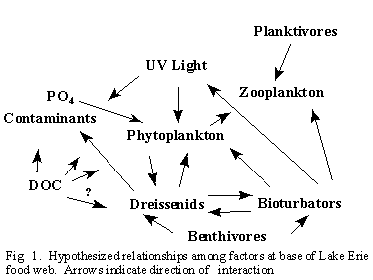Lake Erie Millennium Network
Workshop 1.0 - Factors Regulating Energy at the Base of the Food Web

LEMN Workshop 1.0: "Factors Regulating Energy at the Base of the Food Web" was a binational workshop that was held in Grosse Ile Michigan, USA from October 10th to 11th, 1999.
Workshop Resources
Workshop Agenda and Suggested References: Download (PDF)
Workshop Goal
The goal of this workshop was to develop a series of studies and experiments whose results enabled us identify the major links and factors regulating the flow of energy (carbon) at the base of the Lake Erie food web. A strong inference approach, emphasizing hypothesis generation, prediction and testing, and biologically relevant effect size was used to guide the discussion.
Workshop Background
Limits on Energy Transfer in the Lake Erie Ecosystem - Critical Tests of Hypotheses
Presenters at the Millennium Conference identified important linkages among at least 10 compartments that seem to regulate bottom-up processes in the Lake Erie system (Fig.1). Citations attributed to presenters below refer to chapters in the Millennium Monograph (Ciborowski et al. 2001). (Abstracts of these papers can be viewed in the Proceedings of the Lake Erie and the Millennium binational conference). A suite of investigations will determine which of these linkages are controlling factors and which are cofactors, using a strong inference approach. We emphasize generating specific, unique, a priori predictions of contrasting hypotheses, and conducting key studies that will test those predictions to differentiate among the hypotheses. The purpose of this workshop was to develop studies that will resolve the following questions:1) What is regulating phytoplankton production, biomass, size structure, and composition?
Phosphorus concentrations declined steadily from the 1970s for about 20 years. Levels through the 1990s have paralleled annual precipitation trends (Charlton and Burley 2001; Millard et al. 2001). Chlorophyll concentration dropped markedly in 1990, coincident with widespread establishment of dreissenid mussels. Water transparency, which should facilitate primary production, increased markedl from the early to mid 1990s, possibly reflecting dreissenid filtering activity. Phytoplankton standing stock has declined by approximately 20% from historical levels (Culver et al. 2001), but biomass is significantly below that predicted from empirical chlorophyll-phosphorus relationships (Millard et al. 2001). Furthermore, size structure and composition of the phytoplankton community has changed, possibly in response to dreissenid grazing pressure (Munawar et al. 2001). At the same time, both greater transparency and rising incident UV radiation levels have increased the depth of the euphotic zone (Smith et al. 2001). Midday UV incident radiation now inhibits primary production by up to 80% (Hiriart et al. 2001), and stimulates photolysis of PAHs and related organic compounds into increasingly phytotoxic byproducts (Marwood et al. 2001). Concentrations of essential trace metals are also potentially limiting primary production (Twiss 2001, McKay 2001). We will resolve the relative pressures of phosphorus and trace metal limitation, grazing pressure by dreissenids and zooplankton, UV effects and their interaction with photolytic chemicals on phytoplankton dynamics.